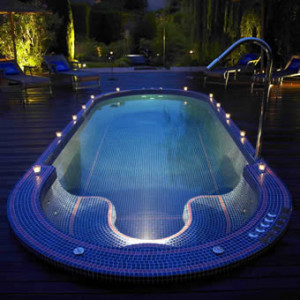To get the most out of your investment, it is essential to make sure you perform essential maintenance regularly. They are not as easy to look after properly as the manufacturers will have you believe.
With your unit you will need to do most of the tasks that are commonly attributed to normal swimming pool maintenance – with a couple of exceptions. Don’t worry though – they are much easier to take care of than a pool.
Getting good water flow in is half of the battle when it comes to keeping a clean ship. With the amount of jets and water disturbance a swim spa creates when in use, half the battle is already won.

That being said you still need to do regular maintenance. Water quality is everything, and 99% of the guide below will be focusing on that. If you keep your water healthy and clean, you will be in very good hands.
Sterilizing or sanitizing your water is obviously very important. Without proper sterilization, all of the germs and other bodily fluids like sweat that are excreted by everyone that uses it will become overpowering very quickly. Thus making your swim spa very unpleasant to be around.
This is much more important than in a swimming pool due the amount of exercise you will be doing (and sweat you will be producing), in a much smaller amount of water than a normal pool.
Chlorine is the standard sanitizer for swimming pools, and will suffice. However the sanitizer of choice for swim spa owners is bromine. Bromine is very similar in its sanitization power to chlorine but does not come with the irritation that chlorine can provide. Bromine also works its best when at higher temperatures, which makes it perfect. It is a little more expensive than chlorine which is why it is not often used in swimming pools that have large amounts of water to disinfect. But for the relatively small amount of water bromine is the best you can get to sanitize your water.
Algae growth is a massive problem for swimming pool owners, but not not so much for us. The reason being that jets when in operation disturb the water so much that it makes it much harder for algae to form.
This being said without proper sanitization it is all too easy for algae to make an unwanted appearance. If you spot any algae at all then there is nothing you can do – the damage has already been done. Immediately drain it give it a good clean with an approved cleaner, and refill it – making sure to repeat all of the steps in this guide with the new water.
[sc:ad]
You will need to measure the alkalinity of your water weekly, it is essentially a test of how hard your water is – testing how much calcium and other chemicals are put in your water by the water companies.
If your water is too hard and left untreated you may have to replace several parts early, as the chemicals in the water (over time) can have a drastic effect on the pumps and jets. There are several water treatment kits available that can alter your water hardness, after a while you will learn exactly how hard your water is (it does not change very often) and testing the alkalinity of your water will become somewhat of a formality.
One of the most important things you will need to learn and become a bit of an expert in is PH levels. A PH level is something many of us will remember from high school chemistry – it is basically a measurement of how acidic or alkaline a substance is.

The PH level effects everything else in terms of maintaining your water. Poor PH level management will make everything else in this guide 10 times harder. If you only manage to get one thing right when your performing maintenance – make it the PH levels. (but try and do everything!)
Your swim spa should have come with a PH tester kit, if not they are readily available. Check the PH of your water at least weekly. An Ideal PH is 7.5 – although 7.4 and 7.6 will suffice. It sounds complicated I know but its not! Simply take a sample of the water and follow the simple instructions on your PH tester kit and you will get the reading. If its too low, add a chemical to increase it, if its too high add a chemical to reduce it. Simple!
Some people recommend using baking soda increase the level of the PH if it is too low, and white wine vinegar or lemon juice if it is too high – we have never tried this and do not recommend it at all. The chemistry makes sense, but I don’t think swim spas are designed to have baking powder, vinegar, and lemon juice thrown into them. In my opinion with the amount of money you will have invested, its not worth the risk to save $20. So just buy the recommended chemicals to avoid headaches.
So there you have it, if you follow these simple maintenance instructions you will have a long lasting happy swim spa for years to come. Do you have any questions about maintenance? Do you have any tips or hints for new owners? Leave a comment below!
